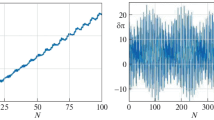Abstract
The reciprocal distance between two material points that rotate around a central body in nonintersecting orbits is expanded and the results are presented. The expansion is obtained accurate to the tenth order with respect to small parameters: the eccentricities and sine of the orbital inclination angle. The result is the basis of the averaging operation of the perturbation function in the system of eight major planets in the solar system, and of the numerical integration of the averaged equations of motion. The averaged Hamiltonian contains the terms whose period of variation is greater than 200 years. Forty eight equation of first order are numerically integrated with increments of 100 years for two intervals from the beginning of the Christian era: 25 million years forward and 25 million years backward over time. To present the results of calculation, the website (URL: http://vadimchazov.narod.ru/secequat.htm) was developed, where the initial codes, executable program modules, the results of calculations presented in graphical form, text files with initial conditions, tables for expanding the reciprocal distance between two material points, and the tables with the results of expansion of the perturbation function for eight major planets of the solar system are presented.
Similar content being viewed by others
References
Anolik, M.V., Krasinskii, G.A., and Pius, L.Yu., Trigonometrical Theory of Secular Perturbations of Big Planets, Trudy ITA AN SSSR, 1969, issue 4, pp. 3–47.
Berger, A., Long-Term Variations of the Earth’s Orbital Elements, Celest. Mech., 1977, vol. 15, pp. 53–74.
Bronshtein, I.N. and Semendyaev, K.A., Spravochnik po matematike (Handbook on Mathematics), Moscow: Nauka, 1981.
Brouwer, D. and van Woerkom, A.G., The Secular Variations of the Orbital Elements of the Principal Planets, Astron. Pap., 1950, vol. 13, pp. 81–107.
Brumberg, V.A., Analiticheskie algoritmy nebesnoi mekhaniki (Analytical Algorithms of Celestial Mechanics), Moscow: Nauka, 1980.
Cohen, G.J., Hubbard, E.C., and Oesterwinter, C., Planetary Elements for 10000000 Years, Celest. Mech., 1973, vol. 7, pp. 438–448.
Duboshin, G.N., Nebesnaya mekhanika. Osnovnye zadachi i metody (Celestial Mechanics. The Main Problems and Methods), Moscow: Nauka, 1975.
Everhart, E., Implicit Single-Sequence Methods for Integrating Orbits, Celest. Mech., 1974, vol. 10, pp. 35–56.
Gerasimov, I.A., Chazov, V.V., Rykhlova, L.V., and Tagaeva, D.A., Construction of the Theory of Motion for Solar-System Bodies Based on a Universal Method for Perturbative Function Calculation, Sol. Syst. Res., 2000, vol. 34, no. 6, pp. 509–516.
Ipatov, S.I., Variations in Orbital Elements of Planets, Sol. Syst. Res., 2000, vol. 34, no. 3, pp. 179–185.
Kuznetsov, E.D. and Kholshevnikov, K.V., Expansion of the Hamiltonian of the Two-Planetary Problem into the Poisson Series in All Elements: Application of the Poisson Series Processor, Sol. Syst. Res., 2004, vol. 38, no. 2, pp. 147–154.
Kuznetsov, E.D. and Kholshevnikov, K.V., Dynamical Evolution of Weakly Disturbed Two-Planetary System on Cosmogonic Time Scales: The Sun-Jupiter-Saturn System, Sol. Syst. Res., 2006, vol. 40, no. 3, pp. 239–250.
Kholshevnikov, K.V. and Kuznetsov, E.D., Review of the Works on the Orbital Evolution of Solar System Major Planets, Sol. Syst. Res., 2007, vol. 41, no. 4, pp. 265–300.
Lagrange, G., Ouevres, Paris, 1870, vol. 5.
Laskar, J., The Chaotic Motion of the Solar System: A Numerical Estimate of the Size of the Chaotic Zones, Icarus, 1990, vol. 88, no. 2, pp. 266–291.
Laskar, J., Large-Scale Chaos in the Solar System, Astron. Astrophys., 1994, vol. 287, no. 1, pp. L9–L12.
Laskar, J., Large-Scale Chaos in the Spacing of the Inner Planets, Astron. Astrophys., 1997, vol. 317, no. 2, pp. L75–L78.
Lidov, M.L., Semi-Analytical Methods for Calculating Satellites Motion, Trudy ITA AN SSSR, 1978, vol. 17, pp. 54–61.
Mel’nikov, V.P. and Smul’skii, I.I., Astronomic Factors Acting to the Earth Astrosphere and Problems of Its Investigation, Kriosfera Zemli, 2004, vol. 8, no. 1, pp. 3–14.
Pitjeva, E.V., High-Precision Ephemerides of Planets-EPM and Determination of Some Astronomical Constants, Sol. Syst. Res., 2005, vol. 39, no. 3, pp. 176–186.
Quinn, T.R., Tremaine, S., and Duncan, M., A Three Million Year Integration of the Earth’s Orbit, Astron. J., 1991, vol. 101, pp. 2287–2305.
Standish, E.M., Newhall, X.X., Williams, J.G., and Folkner, W.F., JPL Planetary and Lunar Ephemerides, DE405/LE405, JPL Interoffice Memorandum, 1998, no. 312.F-98-048, pp. 1–18.
Vashkov’yak, M.A., A Numerical-Analytical Method for Studying the Orbital Evolution of Distant Planetary Satellites, Astron. Lett., 2005, vol. 31, no. 1, p. 64.
Vashkov’yak, M.A. and Teslenko, N.M., Evolution Characteristics of Jupiter’s Outer Satellites Orbits, Sol. Syst. Res., 2008a, vol. 42, no. 4, pp. 291–295.
Vashkov’yak, M.A. and Teslenko, N.M., Evolutionary Characteristics of the Orbits of outer Saturnian, Uranian, and Neptunian Satellites, Sol. Syst. Res., 2008b, vol. 42, no. 6, pp. 488–504.
Author information
Authors and Affiliations
Additional information
Original Russian Text © V.V. Chazov, 2013, published in Astronomicheskii Vestnik, 2013, Vol. 47, No. 2, pp. 112–121.
Rights and permissions
About this article
Cite this article
Chazov, V.V. A way to generate a model of secular perturbations for planetary orbits. Sol Syst Res 47, 99–108 (2013). https://doi.org/10.1134/S0038094613010012
Received:
Published:
Issue Date:
DOI: https://doi.org/10.1134/S0038094613010012




